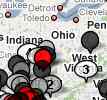Civil War and Strategy
When Union commanders assembled their forces in ways that took full advantage of the technologies, and when they practiced a new form of war making we might call “railroad generalship,” they demonstrated a nearly unassailable confidence in the modern nation. In the Atlanta Campaign William T. Sherman set out to destroy the Confederate railroads and bring the war into the South's “interior.” This capacity for a massive army to operate in the “interior” became the ultimate modern form of war-making that railroads made possible.
Documents related to this topic
U.S. Military Railroads and Black Labor:
-
Letters to and from the U.S.M.R.R. (51):
The U. S. Military Railroads employed over 7,000 men by the end of the war. Hundreds of African Americans left slavery to join the U.S.M.R.R. work crews. They worked to lay track, cut lumber, and haul materials as bridges were built, rebuilt, destroyed and built again. They also worked in machine shops in Nashville, Tennessee, and other sites such as City Point and Alexandria, Virginia. The U.S.M.R.R. was one of the first government organizations to employ black labor and became over the course of the war one of the most extensive employers outside of the U.S.C.T.
-
Photographs (25):
Andrew J. Russell served as the chief photographer for the U.S.M.R.R. and he went to Alexandria, Virginia, as well as other sites in northern Virginia, to photograph black laborers working for the Union army. Russell documented some of the first sites of African American transition to free labor in the war. Other photographers, such as George Barnard, also photographed the Northern armies and the landscapes of the South, particularly the destruction of railroads.
Northern Railroad Building in the War:
-
Civil War Letters of Samuel B. Reed (118):
Samuel B. Reed worked as a chief engineer in Iowa for the Mississippi and Missouri Railroad in the early 1860s and then he moved to the Union Pacific to survey the transcontinental in 1864 and 1865. Eventually Reed became the chief engineer for the Union Pacific. His Civil War letters to and from his wife, Jennie, and his friends and business associates show the way the war affected the extensive railroad construction underway in Iowa. Reed was a Douglas Democrat and often found himself at odds with the Republican policies pursued in the war.
Battles and Railroads:
-
Images and Lithographs (32):
Railroads figured in many Civil War battles. They were represented widely in periodicals and newspapers. They became key strategic objectives in war planning and some of the most visible such objectives for the public.
-
Maps of the War (9):
Railroads figured prominently in maps of the war. Mapmakers, such as J. T. Lloyd in New York, published extensive atlases for the war. Newspapers too began publishing "seat of the war" maps and detailed renderings of the war's geography. Railroads served as one of the most widely recognized markers in any visualization of the conflict.
Views:
-

The Atlanta Campaign of 1864
This view includes the full volume of the Official Records of the War of Rebellion for the Atlanta Campaign, encoded for place names, organization names, and dates and styled to highlight these features in the text. Browse through the highlighted volume to see the Union commanders' descriptions of the geography.
-

Black Labor, Contraband, and the U.S. Military Railroad in the Civil War
This view uses a timeline and map of all instances of black laborers, soldiers, or contrabands on the railroads recorded in the Official Records of the War of Rebellion for the Civil War. Browse through the highlighted events to see the descriptions and categories.